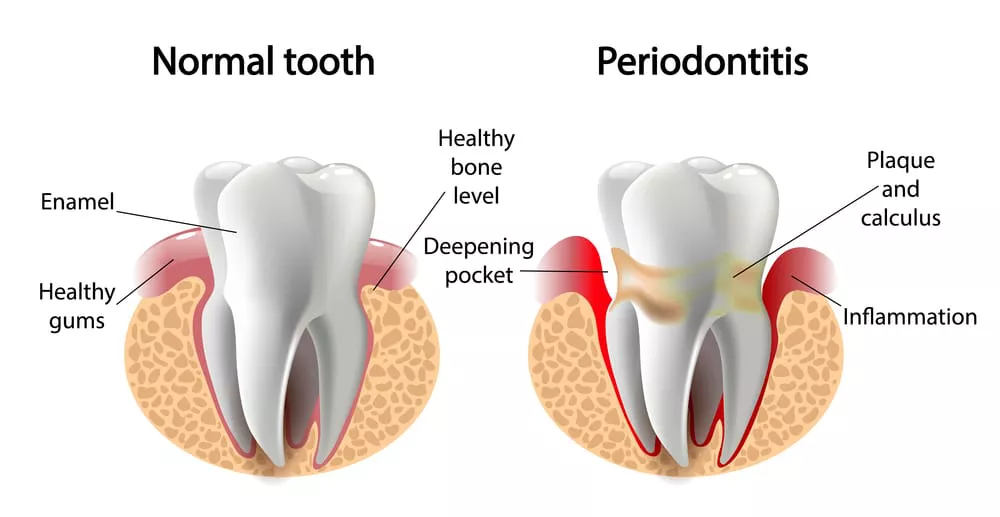Periodontal gum disease, often referred to simply as gum disease, is a common yet serious condition that affects the tissues surrounding and supporting the teeth. It is caused by the buildup of plaque, a sticky film of bacteria that forms on the teeth.
If left untreated, gum disease can lead to tooth loss and other complications. Recognizing the signs and symptoms of periodontal gum disease is crucial for early diagnosis and effective treatment.
Understanding Periodontal Gum Disease
Before delving into the signs and symptoms of gum disease, let’s first understand what it is and how it develops. Periodontal gum disease is a chronic inflammatory condition that affects the gums, bone, and other supporting structures of the teeth.
It starts with the accumulation of plaque, which contains bacteria that produce toxins and irritants. Over time, these toxins and irritants can cause inflammation of the gums, leading to gum disease.
SEE ALSO: How to Treat Advanced Periodontal Disease
How Do You Know If You Have Periodontal Gum Disease
1. There are two main stages of periodontal gum disease:
Gingivitis: This is the early stage of gum disease and is characterized by inflammation of the gums. Symptoms may include redness, swelling, tenderness, and bleeding during brushing or flossing.
Gingivitis is reversible with proper oral hygiene and professional dental care.
Periodontitis: If gingivitis is left untreated, it can progress to periodontitis, a more advanced stage of gum disease.
Periodontitis involves damage to the bone and tissues that support the teeth.
Symptoms may include persistent bad breath, receding gums, loose teeth, and changes in the way your teeth fit together when biting. Periodontitis requires prompt treatment by a dental professional to prevent further damage.
2. Signs and Symptoms of Periodontal Gum Disease
Gums That Bleed Easily: One of the early signs of gum disease is bleeding gums, especially during brushing or flossing.
Healthy gums should not bleed easily, so if you notice blood on your toothbrush or dental floss, it could indicate gum inflammation.
Red, Swollen, or Tender Gums: Inflammation of the gums is a common symptom of gum disease. Healthy gums should appear pink and firm. If your gums are red, swollen, or tender to the touch, it may be a sign of gingivitis or periodontitis.
Receding Gums: As gum disease progresses, the gums may start to pull away from the teeth, leading to gum recession. This can make the teeth appear longer and expose the roots, increasing the risk of tooth sensitivity and decay.
Persistent Bad Breath: Also known as halitosis, persistent bad breath can be a sign of gum disease. The bacteria that cause gum disease can produce foul-smelling compounds, leading to chronic bad breath that does not improve with brushing or mouthwash.
Changes in Tooth Alignment: Advanced gum disease can cause changes in the alignment of your teeth. This may manifest as gaps between teeth, shifting of teeth, or changes in the way your teeth fit together when biting or chewing.
Loose or Shifting Teeth: In severe cases of periodontitis, the bone and tissues supporting the teeth can become damaged, causing the teeth to become loose or shift position. This can affect your bite and make chewing difficult.
Pus Between Teeth and Gums: Infections associated with gum disease can lead to the formation of pus pockets between the teeth and gums. If you notice pus or a discharge from the gum line, it is important to seek dental care immediately.
Pain or Discomfort: Gum disease can cause pain or discomfort in the gums, especially when eating or brushing. This may be accompanied by sensitivity to hot or cold temperatures.
Risk Factors for Periodontal Gum Disease
While anyone can develop gum disease, certain factors can increase your risk:
Poor Oral Hygiene: Inadequate brushing and flossing can lead to plaque buildup and gum disease.
Smoking: Tobacco use can impair gum health and hinder the body’s ability to fight infection.
Genetics: Some individuals may be genetically predisposed to gum disease.
Age: The risk of gum disease increases with age.
Systemic Health Conditions: Conditions such as diabetes, HIV/AIDS, and autoimmune disorders can impact gum health.
Hormonal Changes: Hormonal fluctuations, such as those during pregnancy or menopause, can affect gum sensitivity.
Medications: Certain medications can contribute to dry mouth or gum inflammation.
Diagnosis And Treatment
If you suspect you have gum disease, it is important to see a dentist or periodontist for an evaluation. Diagnosis typically involves a comprehensive examination of the teeth, gums, and supporting structures, along with X-rays to assess bone health.
Treatment for gum disease may include:
Professional Dental Cleaning: Removal of plaque and tartar buildup to prevent further gum inflammation.
Scaling and Root Planing: Deep cleaning to remove bacteria and smooth root surfaces.
Medication: Antibiotics or antimicrobial mouth rinses to control bacterial growth.
Surgical Procedures: In advanced cases, surgical interventions such as flap surgery or bone grafting may be necessary.
Lifestyle Changes: Improving oral hygiene habits, quitting smoking, and managing systemic health conditions.
Preventing Periodontal Gum Disease
Maintaining good oral hygiene is key to preventing gum disease. Here are some tips to keep your gums healthy:
Brush Twice a Day: Use a soft-bristled toothbrush and fluoride toothpaste to brush your teeth thoroughly.
Floss Daily: Clean between your teeth and along the gum line to remove plaque and food particles.
Visit Your Dentist Regularly: Schedule regular dental check-ups and cleanings to monitor your oral health.
Quit Smoking: Smoking can worsen gum disease and hinder treatment outcomes.
Eat a Balanced Diet: Limit sugary snacks and beverages, and consume foods rich in vitamins and minerals.
Manage Stress: Stress can impact oral health, so practice relaxation techniques.
Stay Hydrated: Drink plenty of water to keep your mouth moist and rinse away bacteria.
Conclution
By being aware of the signs and symptoms of gum disease and taking proactive steps to care for your oral health, you can reduce your risk of developing periodontal gum disease and maintain a healthy smile for years to come.

